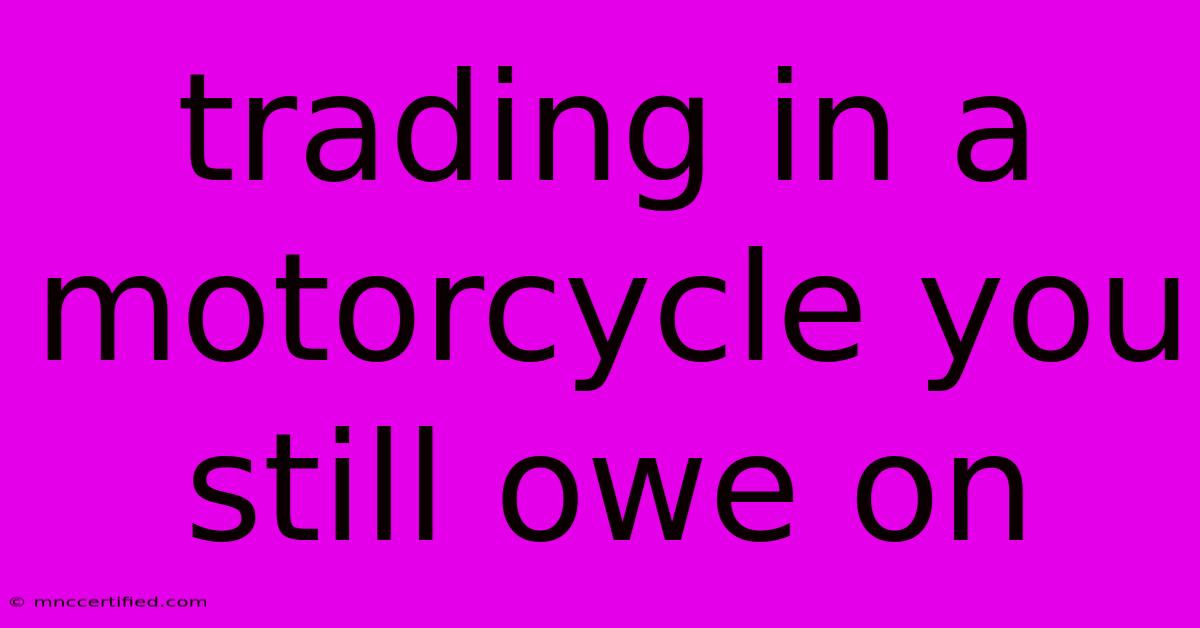Trading In A Motorcycle You Still Owe On

Table of Contents
Trading in a Motorcycle You Still Owe: A Guide to the Process
Owning a motorcycle can be a thrilling experience, but sometimes circumstances change, and it's time to move on to a different ride. If you're still paying off your current motorcycle, trading it in might seem daunting. However, with a little planning and understanding, you can navigate the process smoothly.
This guide breaks down the steps involved in trading in a motorcycle you still owe, providing tips to maximize your chances of a successful transaction.
Understanding the Basics
Before you head to the dealership, it's essential to understand the key factors involved:
- Loan Balance: Your outstanding loan amount will be a significant factor in determining your trade-in value. The closer you are to paying off your loan, the more favorable the outcome.
- Motorcycle's Condition: The condition of your motorcycle directly influences its trade-in value. Maintain regular servicing, address any minor issues, and keep your bike clean.
- Market Value: Research the current market value of your motorcycle model and year. Websites like Kelley Blue Book, NADA Guides, and Cycle Trader can provide valuable insights.
- Trade-in Value vs. Selling Privately: Dealerships offer convenience, but you might get a higher price selling your motorcycle privately. Consider both options carefully.
Steps to Take Before Trading In:
- Review Your Loan Agreement: Understand the terms of your loan, including the remaining balance, interest rate, and any penalties for early repayment.
- Calculate Your Equity: Subtract your outstanding loan balance from your motorcycle's current market value to determine your equity.
- Contact Your Lender: Inform your lender of your intention to trade in the motorcycle. This can help you avoid potential penalties.
- Research Dealerships: Compare trade-in offers from multiple dealerships to find the best deal.
- Negotiate the Trade: Don't be afraid to negotiate the trade-in value. Research market prices and present your findings to the dealership.
How the Trade-In Process Works:
- Appraisal: The dealership will assess your motorcycle's condition and determine a trade-in value.
- Loan Payoff: If the trade-in value exceeds your loan balance, you'll receive the difference as cash or a credit toward your new motorcycle.
- Transfer of Title: You'll need to sign the title over to the dealership.
- New Loan: If the trade-in value is less than your loan balance, you'll need to finance the remaining amount.
Key Tips for Success:
- Maintain a Positive Credit Score: A good credit score can help you secure financing at a lower interest rate.
- Negotiate the Price of Your New Motorcycle: Don't settle for the first offer. Negotiate the price of your new motorcycle to maximize your overall savings.
- Explore All Options: Consider selling your motorcycle privately to potentially get a higher price, but be aware of the added time and effort involved.
Trading in a motorcycle you still owe can be a complex process. By understanding the basics, following the steps outlined above, and negotiating effectively, you can achieve a successful outcome and transition to your next motorcycle with confidence.

Thank you for visiting our website wich cover about Trading In A Motorcycle You Still Owe On. We hope the information provided has been useful to you. Feel free to contact us if you have any questions or need further assistance. See you next time and dont miss to bookmark.
Featured Posts
-
Is Buying An Apartment A Good Investment
Nov 08, 2024
-
Aclu California Trump Reelection Efforts
Nov 08, 2024
-
Starbucks Holiday Menu 2024 Edition
Nov 08, 2024
-
How To Get Insurance To Cover A Nose Job
Nov 08, 2024
-
Scholz Coalition Collapse What Now For Germany
Nov 08, 2024